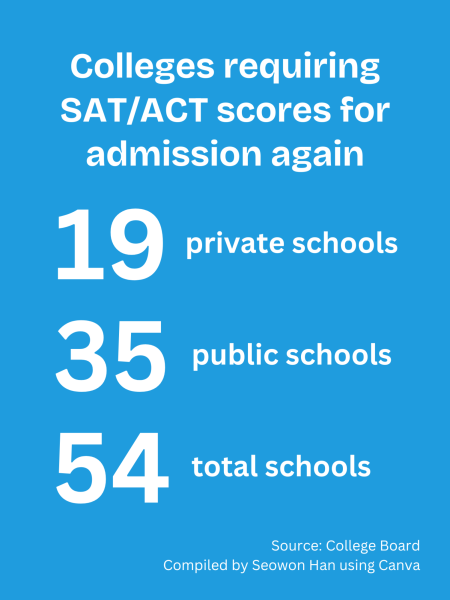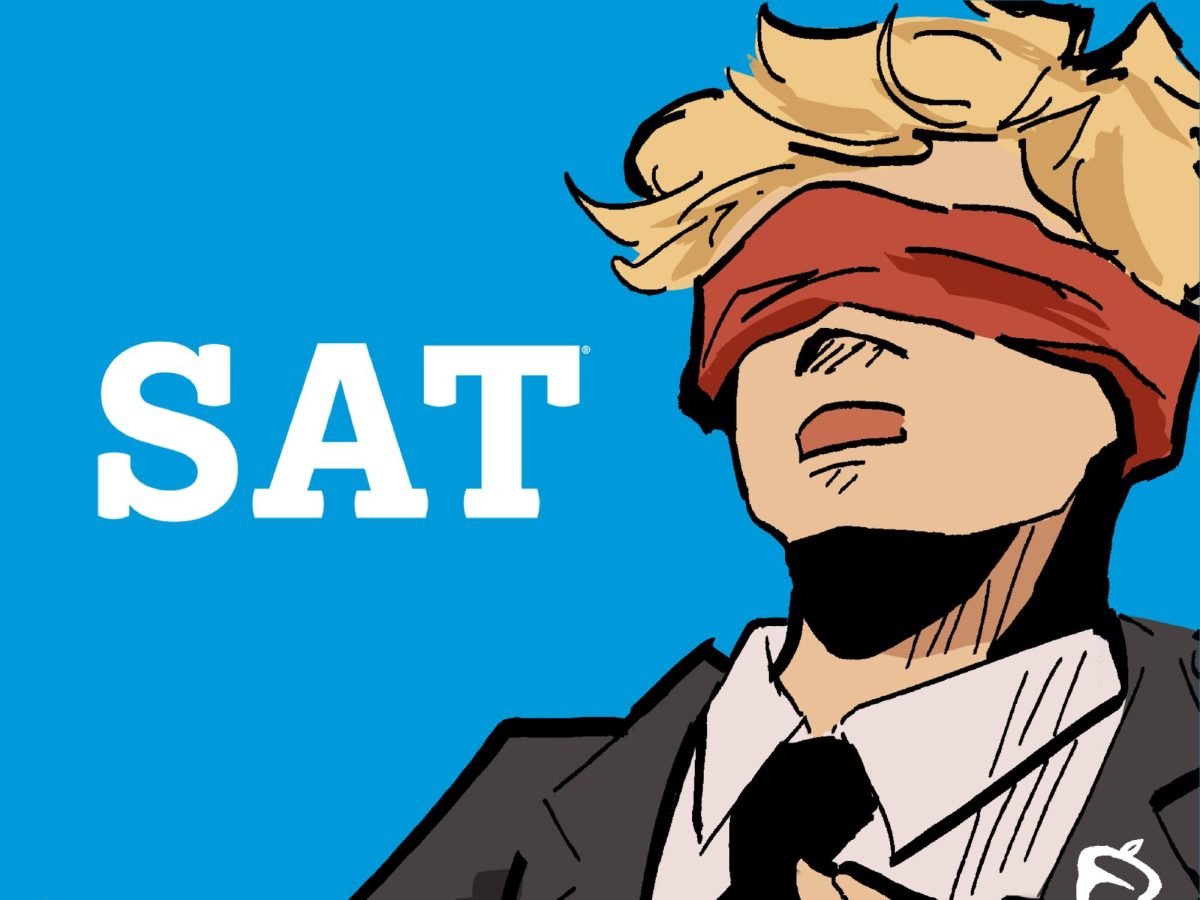This is one of a series of five-year, COVID-19 pandemic anniversary articles The Accolade’s Spotlight team has expanded from its original print version that appeared in the Monday, March 24, issue.
Science teacher Mason Morris was an administrator here before the coronavirus outbreak forced schools to close down in March 2020.
Upon reflecting on the pandemic’s impact on college entrance exams, Morris recalled the academic mindset among students in his classroom.
“I remember that students were always practicing and studying, especially their sophomore year and then their junior and senior year,” he said. “Especially the junior year, trying to take the test one or two times, maybe more, trying to get the scores they would like.”
And then after March 2020, officials from the College Board, which administers the SAT, and ACT Inc., which gives the ACT, acknowledged that students — especially in California — couldn’t take their exams because of lockdown protocols.
That left many to go out of state to find open testing sites, like in Nevada or Arizona.
Junior Rhea Ji visited Arizona during her freshman year to take the SAT.
“Arizona was the closest place I could take the exam,” Ji said. “I was disappointed that I had to go to Arizona to take the exam because I wanted to take it closer, and it was really time-consuming.”
A month into the coronavirus outbreak, the University of California system dropped SAT/ACT test scores as a requirement for admissions. California State Universities followed suit two years later in March 2022.
That didn’t sit well with some students.
“Requiring test scores is more fair than just looking at grades for academics because a lot of schools have grade inflation,” Ji said.
Freshman Viviana Kim said she agrees with Ji as she saw the potential benefits in college admissions.
“I think requiring test scores for college admissions is better because it helps colleges get a rough idea of our academic capabilities,” freshman Viviana Kim said. “I also think it would help them narrow down the pool of applicants, but it shouldn’t be the sole determinant.”
TEST-OPTIONAL, TEST-BLIND
Among college admission websites, words such as “test-optional” and “test-blind” started appearing in 2020.
The former meant that colleges allow students to decide whether to submit their test scores; the latter meant students aren’t able to submit a test score, according to College Board.
Morris said those decisions also had an impact on students.
“It was a real struggle for those kids that had already studied for the SAT or ACT, and then they didn’t have to take it,” said the instructor, who teaches regular and honors chemistry.
 But the recent trend, according to usnews.com, is for higher learning institutions to go back to the way things were before COVID-19 hit. According to College Board, 19 private and 35 public colleges this year have been added to the list of 54 schools that require the SAT or ACT scores again for admission.
But the recent trend, according to usnews.com, is for higher learning institutions to go back to the way things were before COVID-19 hit. According to College Board, 19 private and 35 public colleges this year have been added to the list of 54 schools that require the SAT or ACT scores again for admission.
College and Career Center’s guidance technician, Genesis Perez, lamented such a move.
“Being test-optional or not even asking for these exams is beneficial because a test score does not determine what you know,” Perez said.
Kim, who took the SAT last October, disagreed.
“Several prestigious colleges are bringing back SAT and ACT to get a better idea of the applicant’s academic and education level,” Kim said. “Although these tests don’t fully define a student’s capabilities, I think it gives the colleges a rough idea.”
Kari Morita, an Advanced Placement [AP] Statistics teacher, said she understands why higher-level institutions are reverting back to their pre-COVID-19 pandemic admissions mandates.
“I don’t know if the SAT is the best way to judge, but I could understand, for some colleges, they feel it’s the best option they have,” Morita said. “So if they use that as a tool with other variables to assess whether the student’s a good fit, then I could see why it would play a part.”
Additionally, said she thinks the SAT could have been a helpful tool that places each student in the appropriate college.
“I don’t know if the SAT is the answer, but it sounds like universities are having more trouble with students being placed in,” the math teacher said. “Maybe the SAT was helpful or that or maybe there’s something better that the universities could come up with.”
FROM VIRAL TO DIGITAL
For nearly a century — 1926-2023 — students tested on printed versions of the SAT, and 1959-2025, for ACT. But two years ago, College Board introduced its first digital administration in Asia.
U.S. students took it for the first time last year on March 9. With the last paper exam in December 2023, the digital version is the only way to take the test.
Many said this was inevitable, whether the pandemic had occurred or not.
“I would always hope that COVID-19 never happened, but I believe technology would have caught up, so it would have been digital anyway,” said Ji, who took two digital versions in August 2024 and October 2024.
According to College Board, some advantages are made as the exam shifted from paper to digital:
- a shorter test
- shorter reading passages on the Reading and Writing section
- calculators are allowed for the whole Math section
- a variety of supported devices for students to use are available
- a every student takes a unique version of the test
- students have a shorter test day
“Digital is fair because it has an algorithm to follow,” science teacher David Kim said. “I think it’s a more accurate indication of how well they score compared to paperwork because everyone gets the same questions on paper, but on the digital exam, if you do well, the questions get harder and harder so it matches the levels of the students.”
To prepare for the new digital SAT, Ji said she used practice exams provided by the College Board through Bluebook, a testing application introduced in 2023 that students use to take and practice its exams on.
“I didn’t have a tutor,” said the junior, who got her desired scores taking the digital version. “I just had a lot of practice problems because the internet has a lot of resources, and I took a lot of all the Bluebook exams on the College Board.”
Morita said hearing from her students, they preferred digital tests, but it did not seem to affect them in terms of scores.
“It really has been a non-issue in my AP class being digital or not digital,” she said.
Ji said that for the new exam, students do a pre-screening at home to check their devices and download Bluebook before the test date.
“I didn’t have any concerns or confusion about it,” the junior said. “They explained it really well on their website.”
Unlike the SAT, according to act.org, the ACT offers both paper and online versions of the exam.
According to ACT, some aspects of the exam are changing to the digital version:
- a reduced number of questions
- a reduced test length
- more time per question
- a number of answer choices in math questions reduced from five to four
- students can choose to take the ACT National Test with or without the science section
Ji, who will be applying to schools next year that require SAT scores, said she isn’t worried that her test scores will affect her college application process.
“My external motivating factor is to get a good score on the SAT,” she said. “So I was nervous at first, but upon receiving my score, I realized with hard work, you can get to the median score that a lot of the colleges take.”
According to The Accolade’s online poll released from Thursday, Feb. 13, to Wednesday, April 2, only 22 respondents five years removed from the COVID-19 pandemic outbreak are in favor of making standardized testing scores mandatory, 86 are against and 20 do not care about it as of now.














